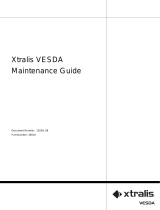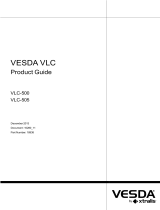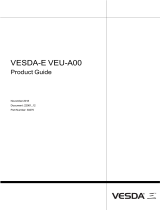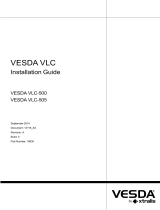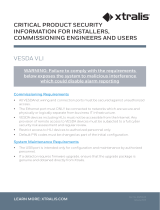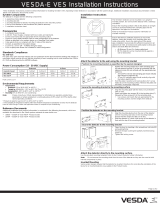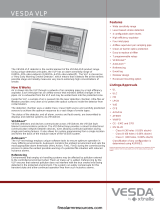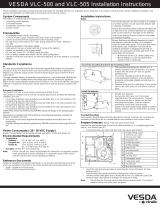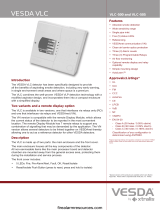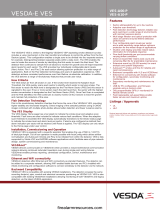Page is loading ...

VESDA VLS
Product Guide
July 2016
Document: 10279_10
Part Number: 19147


VESDA by Xtralis VESDAVLSProduct Guide
www.xtralis.com i
Intellectual Property and Copyright
This document includes registered and unregistered trademarks. All trademarks displayed are the trademarks of
their respective owners. Your use of this document does not constitute or create a licence or any other right to use
the name and/or trademark and/or label.
This document is subject to copyright owned by Xtralis AG (“Xtralis”). You agree not to copy, communicate to the
public, adapt, distribute, transfer, sell, modify or publish any contents of this document without the express prior
written consent of Xtralis.
Disclaimer
The contents of this document is provided on an “as is” basis. No representation or warranty (either express or
implied) is made as to the completeness, accuracy or reliability of the contents of this document. The manufacturer
reserves the right to change designs or specifications without obligation and without further notice. Except as
otherwise provided, all warranties, express or implied, including without limitation any implied warranties of
merchantability and fitness for a particular purpose are expressly excluded.
General Warning
This product must only be installed, configured and used strictly in accordance with the General Terms and
Conditions, User Manual and product documents available from Xtralis. All proper health and safety precautions
must be taken during the installation, commissioning and maintenance of the product. The system should not be
connected to a power source until all the components have been installed. Proper safety precautions must be taken
during tests and maintenance of the products when these are still connected to the power source. Failure to do so
or tampering with the electronics inside the products can result in an electric shock causing injury or death and may
cause equipment damage. Xtralis is not responsible and cannot be held accountable for any liability that may arise
due to improper use of the equipment and/or failure to take proper precautions. Only persons trained through an
Xtralis accredited training course can install, test and maintain the system.
Liability
You agree to install, configure and use the products strictly in accordance with the User Manual and product
documents available from Xtralis.
Xtralis is not liable to you or any other person for incidental, indirect, or consequential loss, expense or damages of
any kind including without limitation, loss of business, loss of profits or loss of data arising out of your use of the
products. Without limiting this general disclaimer the following specific warnings and disclaimers also apply:
Fitness for Purpose
You agree that you have been provided with a reasonable opportunity to appraise the products and have made
your own independent assessment of the fitness or suitability of the products for your purpose. You acknowledge
that you have not relied on any oral or written information, representation or advice given by or on behalf of Xtralis
or its representatives.
Total Liability
To the fullest extent permitted by law that any limitation or exclusion cannot apply, the total liability of Xtralis in
relation to the products is limited to:
i. in the case of services, the cost of having the services supplied again; or
ii. in the case of goods, the lowest cost of replacing the goods, acquiring equivalent goods or having the goods
repaired.
Indemnification
You agree to fully indemnify and hold Xtralis harmless for any claim, cost, demand or damage (including legal costs
on a full indemnity basis) incurred or which may be incurred arising from your use of the products.
Miscellaneous
If any provision outlined above is found to be invalid or unenforceable by a court of law, such invalidity or
unenforceability will not affect the remainder which will continue in full force and effect. All rights not expressly
granted are reserved.

VESDAVLSProduct Guide VESDA by Xtralis
ii www.xtralis.com
Scope
This manual is written to provide you with comprehensive knowledge of the detector.
This manual introduces you to the VESDA VLS features, technical specifications and gives an understanding
of its components and their function. You will also find instructions on installing, cabling and powering up the
detector.
This manual is for anyone involved with the design, maintenance and purchasing of the VESDA system. It is
assumed that anyone using this manual has knowledge and the appropriate certification from the local fire and
electrical authorities.
Document Conventions
The following typographic conventions are used in this document:
Convention Description
Bold Used to denote: emphasis.
Used for names of menus, menu options, toolbar buttons.
Italics Used to denote: references to other parts of this document or other
documents. Used for the result of an action.
The following icons are used in this document:
Convention Description
Caution: This icon is used to indicate that there is a danger to
equipment. The danger could be loss of data, physical damage, or
permanent corruption of configuration details.
Warning: This icon is used to indicate that there is a danger of electric
shock. This may lead to death or permanent injury.
Warning: This icon is used to indicate that there is a danger of inhaling
dangerous substances. This may lead to death or permanent injury.
Contact Us
UK and Europe +44 1442 242 330
D-A-CH +49 431 23284 1
The Americas +1 781 740 2223
Middle East +962 6 588 5622
Asia +86 21 5240 0077
Australia and New Zealand +61 3 9936 7000
www.xtralis.com

VESDA by Xtralis VESDAVLSProduct Guide
www.xtralis.com iii
Codes and Standards Information for Air Sampling Smoke Detection
We strongly recommend that this document is read in conjunction with the appropriate local codes and standards
for smoke detection and electrical connections. This document contains generic product information and some
sections may not comply with all local codes and standards. In these cases, the local codes and standards must
take precedence. The information below was correct at time of printing but may now be out of date, check with your
local codes, standards and listings for the current restrictions.
FCC Compliance Statement
This equipment has been tested and found to comply with the limits for a Class B digital device, pursuant to part 15
of the FCC Rules. These limits are designed to provide reasonable protection against harmful interference in a
residential installation. This equipment generates, uses and can radiate radio frequency energy and, if not installed
and used in accordance with the instruction, may cause harmful interference to radio communications. However,
there is no guarantee that interference will not occur in a particular installation. If this equipment does cause
harmful interference to radio or television reception, the user is encouraged to try to correct the interference by one
or more of the following measures; re-orientate or relocate the receiving antenna, increase the separation between
the equipment and receiver, connect the equipment to a power outlet which is on a different power circuit to the
receiver or consult the dealer or an experienced radio/television technician for help.
FDA
This Xtralis product incorporates a laser device and is classified as a Class 1 laser product that complies with FDA
regulations 21 CFR 1040.10. The laser is housed in a sealed detector chamber and contains no serviceable parts.
The laser emits invisible light and can be hazardous if viewed with the naked eye. Under no circumstances should
the detector chamber be opened.
FM Hazardous Applications
3611 Hazardous Approval Warning: Exposure to some chemicals may degrade the sealing of relays used on the
detector. Relays used on the detector are marked “TX2-5V”, “G6S-2-5V” or “EC2-5NU”.
VESDA detectors must not be connected or disconnected to a PC while the equipment is powered in an FM
Division 2 hazardous (classified) location (defined by FM 3611).
FM Approved Applications
The product must be powered from VPS-100US-120 or VPS-100US-220 only.
ONORM F3014
ONORM F3014, transport times for all tubes (including capillaries) must not exceed 60 seconds from any hole. This
means that the predesigned pipe networks that include capillaries cannot be used.
AS1603.8
The performance of this product is dependent upon the configuration of the pipe network. Any extensions or
modifications to the pipe network may cause the product to stop working correctly. You must check that ASPIRE
approves alterations before making any changes. ASPIRE is available from your VESDA ASD distributor.
AS1851.1 2005
Maintenance Standards. Wherever this document and the AS1851.1 differ, AS1851.1 should be followed in
preference to this document.

VESDAVLSProduct Guide VESDA by Xtralis
iv www.xtralis.com
Regional Regulatory Requirements and Notices
UL
For open area protection the fire alarm threshold (signal) that initiates an evacuation procedure via the Fire Alarm
Panel must not be set less sensitive than 0.625%/ft. The detector can send this signal via the Fire Alarm Panel
Output signal or the Pre-alarm output signal.
Through validation testing, Underwriters Laboratories Inc. has verified that VESDA ECO gas detectors, when
installed within the sample pipe network, present no significant effects on the smoke detection performance of
VESDA. The use of the ASPIRE calculation software is required to verify system design performance with all
devices included in the design.
European Installations
The product must use a power supply conforming to EN54: Part 4.
EN54-20
The product must use a power supply conforming to EN 54-4.
The product is compliant with EN 54-20 sensitivity requirements provided the following conditions are met:
l For a Class A detector, hole sensitivity must be better than 1.5% obscuration/m and transport time less than
75 seconds
l For a Class B detector, hole sensitivity must be better than 4.5% obscuration/m and transport time less than
90 seconds
l For a Class C detector, hole sensitivity must be better than 10% obscuration/m and transport time less than
90 seconds
The product is compliant with EN 54-20 flow monitoring requirements provided the following conditions are met:
l The minor low and minor high flow thresholds should be set at 80% and 115% respectively
l The flow through the detector predicted by ASPIRE should be in the range 20 to 115 lpm
These limits should be verified using ASPIRE during the design of the sampling pipe network.
Additional information:
l Class A detectors passed EN 54-20 approvals testing with 40 holes and 0.08% obscuration/m detector
sensitivity
l Class B detectors passed EN 54-20 approvals testing with 40 holes and 0.23% obscuration/m detector
sensitivity
l Class C detectors passed EN 54-20 approvals testing with 60 holes and 0.65% obscuration/m detector
sensitivity
Product Listings
l UL
l ULC
l FM
l CCC
l ActivFire
l CE
l LPCB
l VdS
l VNIIPO
l NF
l EN 54-20
Regional approvals listings and regulatory compliance vary between VESDA product models. Refer to
www.xtralis.com for the latest product approvals matrix.
Document: 10279_10
Part Number: 19147

VESDA by Xtralis VESDAVLSProduct Guide
www.xtralis.com i
Table of Contents
1 Introduction 1
1.1 Features 1
2 Operation 3
2.1 The Scanning Function 4
2.2 VESDA VLS Configurations 6
2.3 VESDA VLS Components 10
3 Product Information 11
3.1 Product Specifications 11
3.2 Dimensions 13
3.3 Default Settings 14
3.4 Relays 16
4 Mounting the Detector 19
4.1 Securing the mounting bracket 19
4.2 Mounting the Detector in Normal Orientation 19
4.3 Mounting the Detector in the Inverted Orientation 20
4.4 Mounting the Detector without mounting bracket 20
4.5 Recess mounting kit 21
5 Connecting to the Pipe Network 23
5.1 Inlet Pipes 23
5.2 Managing the Exhaust Air 24
6 Wiring Connections 25
6.1 Termination Card 25
7 Power Source 29
8 Backup Battery Power 31
8.1 Backup battery size calculation sheet 31
9 Starting Up 33
9.1 Installation Checklist 34
10 Preliminary Systems Check 35
11 Maintenance 37
11.1 Replacing the chassis/Air Inlet Pipe Manifold 38
11.2 Internal Wiring for the VESDA VLS 40
12 Spare Parts 43
Index 45

VESDAVLSProduct Guide VESDA by Xtralis
ii www.xtralis.com
This page is intentionally left blank.

VESDA by Xtralis VESDAVLSProduct Guide
www.xtralis.com 1
1 Introduction
The VESDA VLS is an aspirating smoke detector providing very early warning of fire conditions by drawing air
samples through an air sampling pipe network. The detector chamber can detect presence of smoke at very
low concentrations. The embedded and PC software complimenting the VESDA VLS provides a wide range
of user defined parameters and reporting capabilities. The detector easily interfaces with fire warning and fire
suppression release systems, and can be easily integrated into a building management system.
The VESDA VLS can monitor and individually report on four sectors in the protected area.
1.1 Features
The VESDA VLS features make it a versatile smoke detection product:
l Wide sensitivity range 0.005% obs/m to 20.0% obs/m (0.0016% obs/ft. to 6.24% obs/ft.)
l Each detector can cover an area of up to 2,000 m² (21,520 sq. ft.)
l Four programmable alarm thresholds (Alert, Action, Fire 1 and Fire 2)
l AutoLearn feature
l Four pipe inlets
l Individual pipe flow monitoring
l Scans individual sectors once smoke has been detected
l Replaceable air filter cartridge
l Option for inverted mounting
l Recessed mounting option
l Modular to meet site specific requirements
l Modular Display Module and LCD Programmer
l Programmable relays (option for 7 or 12 relays available)
l High efficiency aspirator
l Programmable General Purpose Input (GPI) to invoke operational modes
l PC programming and monitoring
l Multilingual displays
l Event Log for up to 18,000 events

VESDAVLSProduct Guide VESDA by Xtralis
2 www.xtralis.com
This page is intentionally left blank.

VESDA by Xtralis VESDAVLSProduct Guide
www.xtralis.com 3
2 Operation
An air sampling pipe network with sampling holes at appropriate spacing collects air samples from a protected
area.
An integrated Aspirator draws air in the sampling pipes through a Pipe Inlet Manifold (up to four pipes can be
connected to a VESDA VLS detector). For further information on air sampling pipe network, refer to the Pipe
Network Design and Installation Manuals.
Each pipe inlet in the manifold has a valve that can open or close the flow of air to the pipe. The scan function
controls the opening and closing of the valves to detect the smoke carrying pipe. Refer to Section 2.1 on page
4 for further information.
Some of the sampled air flows to the dual stage air filter. The first stage filtration removes dust and dirt from
the sampled air and a small percentage of this air then flows to the laser detector chamber for detection
smoke.
Any smoke detected in the laser detection chamber is signaled to the main processor card. If the presence of
detected smoke is higher than the set thresholds it will be reported as an alert, action, fire 1 or fire 2 Alarm
depending upon the set alarm thresholds. The second stage filtration further filters the air to make it ultra clean
air. The ultra clean air is used to protect the optical surfaces in the laser detector chamber.
Legend
A Air inlets from pipe networks D -flows into the chamber for testing
B Air is drawn into the aspirator E -is filtered a second time, then used
to flush the chamber with ultra clean
air
C Some air is filtered and: F All air is then exhausted
Figure 2-1: Operation and internal air flow of a VESDA VLS

VESDAVLSProduct Guide VESDA by Xtralis
4 www.xtralis.com
2.1 The Scanning Function
The VESDA VLS is designed to sample air from different sectors and to identify through a scanning process
the sector reporting presence of smoke.
2.1.1 Scanning
During normal operation the scanner valves remain open and the VESDA VLS draws air from all the pipes.
When smoke is detected at a higher level than the scan threshold, for a period exceeding the configured scan
delay (0 to 10 seconds), the detector performs a fast scan. During the fast scan operation the VESDA VLS
samples air from each sector (pipe) separately by controlling the scanner valves in the inlet manifold. The fast
scan sequence for each pipe is approximately 4 seconds.
The sector reporting the highest level of smoke above the alert threshold is designated as the first alarm
sector. The display modules assigned to the detector reports this by illuminating the first alarm and alert
LEDs, and displaying the corresponding pipe number on the numeric screen.
Having identified the first alarm sector, the VESDA VLS performs a slow scan using intelligent sequencing.
The sector with the highest level of smoke (the first alarm sector) is scanned first. Each of the other sectors is
scanned one at a time. Intelligent sequencing scans the first alarm sector in every alternate scan (e.g. if all the
pipes are in use and pipe 1 corresponds to the first alarm sector then intelligent sequencing will scan Pipe
1,2,1,3,1,4,1,2......). The time spent sampling air in each sector depends upon the configured sector time.
2.1.2 Adaptive scan threshold
The scan threshold is the configured threshold at which the detector commences scanning once smoke has
been detected at the threshold. The VESDA VLS performs an adaptive scan process to automatically set
scan thresholds at the optimized level. The adaptive scan threshold process is explained below:
l Typically separate scan thresholds are set for day and night periods.
l Scan thresholds are initially set to the lowest day or night alert threshold divided by the number of
pipes. If the threshold is set by AutoLearn, the day or Night Alert Threshold is divided by 2.
l The scan thresholds are then adapted automatically to eliminate unnecessary and excessive scan
cycles.
l Adapting the scan threshold upwards - When the detected smoke level is lower than the
configured Alert Threshold, the scan threshold increases upwards by 0.005% obs/m (0.0016%
obs/ft) with every fast scan cycle. It will continue to do so until the scan threshold is above the
ambient smoke level or it equals the Alert Threshold. The scan threshold cannot exceed the
Alert Threshold.
l Adapting the scan threshold downwards - At every changeover time (from Day to night and
from night to day) the detector determines if it is necessary to adapt the scan threshold
downwards. Thus, if the scan threshold has been adjusted upwards, then in the following 24
hour period the detector begins a process of gradually lowering the scan threshold downwards
to an optimum setting. The detector maintains a record of the maximum smoke readings
measured in each day (or night) period. At the start of the next day (or night) period the scan
threshold is automatically scaled downwards by calculating the difference between the current
scan threshold and the maximum smoke reading for the previous day (or night) period.
2.1.3 The Scanner Valve Test
The VESDA VLS performs a scanner valve test when first powered up. Thereafter a valve test is performed
every alternate Tuesday at 12:00 hours. During the valve test each valve is individually closed and opened to
ensure its proper functioning. Any improper functioning is reported as a fault (refer to the VESDA
Troubleshooting Guide for fault descriptions and troubleshooting). It is possible to simulate a valve scan test
by pressing the Silence/Scan button on the Display Module for two seconds, or selecting the scan test option
under the diagnostics menu on the LCD programmer or the device menu on the PC software.

VESDA by Xtralis VESDAVLSProduct Guide
www.xtralis.com 5
2.1.4 Sector Factor
By setting appropriate sector factors it is possible to set different alarm thresholds for each of the four sectors.
The detector uses the sector factor to automatically calculate the alarm thresholds appropriate for each sector
based on the configured alarm thresholds. These are multiplied by the sector factor to set the sector alarm
thresholds.
Guidelines for setting sector factors:
l Sector factors range between 0.5 and 2.0
l Where more sensitive protection is desired for a sector (for example a critical server room where there
are relatively more sampling holes and restricted access), set the sector factor at less than 1.0
l Where less sensitive protection is desired for a sector (for example where there is a risk that a
particular local process will generate nuisance alarms), set the sector factor at greater than 1.0
l As a general rule, the difference between all pipes should not be greater than 1
Sector factors are generally optimized after a detector has been operational for a period and sufficient
historical data has been gathered in the event log to assist the decision. However, if it is required to pre-
determine the appropriate setting for sector factor the following methodology can be used:
l Use ASPIRE Pipe Modelling Software to model the intended pipe layout
l Determine the appropriate fire sensitivity required for each sector to achieve the desired hole
sensitivity in each sector
l Select an appropriate median setting for the Fire 1 threshold to be configured in the detector and
calculate the appropriate sector factor which, when multiplied by the configured Fire 1 threshold, will
give the desired fire sensitivity for each pipe
l Record the desired Fire 1 threshold setting and sector factor setting for configuration into the detector
at commissioning.

VESDAVLSProduct Guide VESDA by Xtralis
6 www.xtralis.com
2.2 VESDA VLS Configurations
One or more devices can be integrated with the VESDA VLS detector. These are normally configured at the
factory prior to shipping, but can also be installed at a later time. The standard VESDA VLS comes with 7
relays or in an optional 12 relay version. The modules that can be integrated are:
l Display Module
l LCD Programmer Module
l Fire and OK LEDs (FOK) Module
Legend
A Blank Plate
B LCD Programmer
C VESDA VLS Display Unit
Figure 2-2: VLS-214 with 7 relays, blank plate, LCD Programmer and Display Module

VESDA by Xtralis VESDAVLSProduct Guide
www.xtralis.com 7
2.2.1 Display Module
The VESDA VLS Display Module is mounted either on the detector front cover or at a remote location in a
remote mounting box or a 19" subrack. It provides a visual representation of the smoke levels and the four
alarm stages for the assigned detector. An array of fault LEDs light up in different configurations to report
Urgent, Minor, Zone and System faults. Up to 20 Display Modules can be assigned to one detector, however
the Display Module can be configured to report the status of only one detector at a time.
Legend
A Threshold Indicators
B Bar graph
C Numerical Display
D Alarm Level LEDs
E Fault LEDs
F Push Button Keys
Figure 2-3: VESDA VLS Display Module
OK LED The OK LED stays lit during normal operation indicating the unit is functioning
normally. When this LED is off a warning beep sounds, indicating a Fault condition
is active.
Isolate LED This LED is lit when the detector is Isolated and relays are de-activated disabling
alarm outputs of the detector. The display can be programmed to beep every 60
seconds.
Alarm Levels ALERT: When lit this LED indicates that the smoke level is above the alert
threshold. This means the detector has identified very early stages of a fire
condition and/or that the smoke level in the area is above normal.
ACTION: When lit this LED indicates that the detected smoke level has passed
the threshold value fixed for Action, but is not intended to initiate a general fire
alarm response procedure.
FIRE 1: When lit this LED indicates that the detected smoke level is above the
threshold value set to initiate a general fire alarm response procedure. This
indicates a fire may be imminent or is in progress. When interfaced with a Fire
Alarm Control Panel (FACP) it can generate an automatic fire alarm.
FIRE 2: When lit this LED indicates a fire is in progress. The detector can be
interfaced with an FACP to activate automatic suppression systems and
evacuation procedures.
Bar Graph The Bar graph is a 20 step indicator where each indicator represents an increase in
the detected level of smoke, relative to the preset fire alarm level.
Table 2-1: Remote Display Module

VESDAVLSProduct Guide VESDA by Xtralis
8 www.xtralis.com
Threshold Indicators The illuminated LEDs represent visual settings for ALERT, ACTION, and FIRE 1
alarm levels. The FIRE 1 indicator is always at the top.
Fault LEDs The Fault LEDs illuminate to indicate:
URGENT: A serious fault requiring immediate attention
SYSTEM: A fault affecting the network to which the Display module is connected
ZONE: A fault in the VESDA Zone monitored by the Display module
POWER: A fault in the power supply if the GPI function is used
NETWORK: A communications fault on VESDAnet
AIRFLOW: Higher or lower than acceptable levels of air flow through the inlet pipe
(s)
FILTER: The air filter requires changing
Push Button Keys These buttons enable various systems functions. These do not allow configuring
the system. The buttons can be disabled by the systems administrator.
Mode/Test (Dual Function): Selects modes on the numerical display - sensitivity,
smoke level, or zone number. When depressed for more than 2 seconds it performs
a light test function.
Silence/Scan (Dual Function): This button has dual functions. It silences any
alarm or fault warnings. Any LEDs flashing to indicate an alarm condition or a fault
will stop flashing. When pressed for two seconds it initiates a Scan Test.
Reset: Resets any latched alarms and faults on the detector. Any active alarms or
faults are reported again after the time delays have elapsed.
Isolate: Isolates the detector from any external devices or systems (an isolate
alarm will normally be raised at the fire alarm control panel).
Note: It is recommended practise to signal the Isolate condition to the Fire
Control Panel using the Isolate relay.
Numerical Display Sensitivity: Shows the level of smoke that must be measured to illuminate the
entire bar graph and always corresponds with the Fire 1 alarm level.
Smoke Level: Indicates the current level of smoke in the relevant VESDA Zone
and is represented as % obs/m or % obs/ft.
Zone Number: This is the VESDA Zone number assigned to the Display Module.
First Alarm Sector: This is the pipe with the highest level of smoke and is
represented with a "P" followed by the pipe number.
Note: The Mode button is used to select the parameter to display in the
numeric display. These values represent the current readings for the
corresponding parameters mentioned alongside the lit LED.
Table 2-1: Remote Display Module (continued...)

VESDA by Xtralis VESDAVLSProduct Guide
www.xtralis.com 9
2.2.2 Display during the scan process
Legend
A FAS indicator
B Numeric display
C Alert alarm light
VESDA VLS in a scan mode VESDA VLS immediately after a
fast scan mode if a fire condition
is generated
Figure 2-4: The Display Module when the VESDA VLS is in a scan mode and immediately after the scan
mode has been completed
2.2.3 LCD Programmer
The LCD Programmer is used for configuring, commissioning and maintenance of the devices on VESDAnet.
It can replace either the center or the right plate of the front cover of the detector, or can be mounted at a
remote location. A hand-held model is also available. The hand-held model is connected to the VESDAnet
socket on the termination card of the detector. For a detailed description and use of the LCD Programmer
please refer to the VESDA LCD Programmer Product Guide.
The LCD Programmer can be configured to a particular VESDA Zone. If so programmed, the LCD
Programmer automatically displays the relevant sector information for individual sectors when it is scanning.
Legend
A Display
B Keys
Figure 2-5: LCD programmer

VESDAVLSProduct Guide VESDA by Xtralis
10 www.xtralis.com
2.3 VESDA VLS Components
Legend
A Front Cover E Pipe Inlet Manifold
B Termination Card F Air Filter
C Blank Card Protecting Processor Card G Aspirator
D Chassis with Laser Detector Chamber H Mounting Box/Enclosure
Figure 2-6: An exploded view of the detector

VESDA by Xtralis VESDAVLSProduct Guide
www.xtralis.com 11
3 Product Information
3.1 Product Specifications
Specification Value
Supply Voltage 18 to 30 VDC
Power Consumption @24 VDC
- VLS with Blank Plates 3,000rpm l Normal: 5.8 W
l Alarm On: 6.24 W
- VLS with Blank Plates @ 4,200rpm l Normal: 6.72 W
l Alarm On: 7.2 W
- Programmer Module l Normal: 0.6 W (Backlight Off)
l Alarm On: 2.2 W (Backlight On)
- Display Module l Normal: 1.6 W
l Alarm On: 2.2 W
Dimensions (WHD) 350 mm x 225 mm x 125 mm (13.8 in x 8.9 in x 4.9 in)
Weight 4.0 kg (9 lbs) including Display and Programmer Modules
Operating Conditions
(To operate the VESDA VLS
detector outside these parameters
please contact your nearest VESDA
Office)
Temperature:
l Tested to: -10°C to 55°C (14°F to 131°F)
l Detector Ambient: 0°C to 39°C (32° to 103°F)
l Sampled Air: -20° to 60° C (-4° to 140° F)
Humidity:
l 10-95% RH, non-condensing
Storage Conditions
(Non-operational)
l Battery Life: Up to 2 years
l Humidity: Dry (<95%)
l Temperature: 0° to 85° C
l Must not exposed to sunlight or other radiation sources
Sampling Pipe Network l Maximum area of coverage: 2000 m² (21520 sq. ft.)
l Maximum length per pipe: 100 m (328 ft)
l Aggregate pipe length: 200 m (656 ft)
l Minimum flow per pipe: 15 liters/min
l Pipe Modelling Design Tool:ASPIRE
These pipe lengths represent best practice for systems with single pipe runs on each
port (no branching). For longer and/or more complex pipe arrangements, predictions
of EN54-20 compliance are determined using ASPIRE.
Pipe Size l Internal Diameter: 15-21 mm (9/16 - 7/8 in)
l External Diameter: 25 mm (1 in)
25 mm to 1 inch adaptor supplied for USA market.
Relays 7 or 12 relays option. Contacts rated 2A @ 30 VDC
Programmable to latch or non-latch states.
Relays Default Configuration 7 relays: Alert, Action, Fire 1, Fire 2, Minor Fault, Urgent Fault and
Isolate. (7 x NO/NC contacts)
12 relays: Alert, Action, Fire 1, Fire 2, Minor Fault, Urgent Fault and
Isolate, First Alarm sector 1 to 4 and Scan. (10 x NO, 2 x NO/NC
contacts)
Scan Sector Delay (Period) Minimum 8 seconds, maximum 15 seconds
Scan Threshold Delay Minimum 0 seconds, maximum 10 seconds
Table 3-1: Product Specifications

VESDAVLSProduct Guide VESDA by Xtralis
12 www.xtralis.com
Specification Value
IP Rating IP30
Cable Access 8 x 25 mm (1in) knockouts in various positions
Cable Termination Screw terminal blocks (0.2-2.5 sq mm, 30-12 AWG)
Sensitivity Range 0.005 to 20% obs/m (0.0015 to 6.25% obs/ft.)
Threshold Setting Range l Alert: 0.005 - 1.990% obs/m
(0.0016 - 0.6218% obs/ft.)
l Action: 0.010 - 1.995% obs/m
(0.0031 - 0.6234% obs/ft.)
l Fire 1: 0.015 - 2% obs/m
(0.0046 - 0.625% obs/ft.)
l Fire 2: 0.020 - 20% obs/m
(0.0063 - 6.25% obs/ft.)**
** Limited to 12% obs/m 4% obs/ft. in UL mode
All shipments are factory configured for UL Mode. If the UL Mode is
switched OFF the UL listing will be voided.
Table 3-1: Product Specifications (continued...)
3.1.1 Key Software Features
Event log
Up to 18,000 events stored on FIFO basis
AutoLearn
Minimum: 15 minutes
Maximum: 15 days, 23hrs, 59 minutes
Recommended minimum period: 1 day
During AutoLearn, thresholds (i.e. alarm thresholds) are NOT changed
from pre-set values
Referencing Compensation for external ambient conditions
Four Alarm Levels Alert, Action, Fire 1 and Fire 2
Two Fault Warning Levels Minor Fault and Urgent fault
Software Programmable relays 7 or 12
Maintenance Aids
Filter and flow monitoring
Event reporting via VESDAnet or event log
Auto Scan and Threshold Settings Detector selects the appropriate scan threshold automatically
/
